100 Years of Federal Forestry
Agriculture Information Bulletin No. 402
|

|

|
|
President Theodore Roosevelt and Chief Forester Gifford
Pinchot on the river steamer MISSISSIPPI. They made this trip
with the Inland Waterways Commission down the Mississippi River
in October 1907, to awaken interest in the development of our
inland waterways. (F—523656)
|
"Forestry is the preservation
of forests by wise use . . . forestry means making the forests useful
not only to the Settler, the rancher, the miner, the men who live in the
neighborhood, but indirectly to the men who may live hundreds of miles
off down the course of some great river which has had its rise among the
forest bearing mountains."
President Theodore Roosevelt
The Early Years Of The Forest Service, 1905-1916
Highlights
The early years of the Forest Service were a period
of pioneering in practical field forestry in the United States.
"Conservation" began to be practiced and the term became widely known.
Webster defines conservation "especially" as "planned management of a
natural resource to prevent exploitation, destruction, or neglect."
Broad popular support of resource conservation encouraged dramatic
forestry progress in the early years, stimulated by Pinchot and his
small but able and dedicated staff. The close warm relationship and
respect between President Theodore Roosevelt and the Nation's Chief
Forester Gifford Pinchot fostered the development of resource
conservation. Congress helped by passing favorable legislation.
A new era in forestry began in 1905 as Congress
transferred the Forest Reserves from the Department of the Interior to
the Department of Agriculture. The Bureau of Forestry became known as
the Forest Service, the first of many Federal agencies to adopt the
designation of "Service." two years later, to emphasize that the forests
were for use, the name Forest Reserve was changed to National Forest.
Administration was decentralized to take maximum advantage of local
judgment.
The early day forest rangers, riding horseback over
mountain trails, were essentially custodians of the forests, protecting
them against fire, game poachers, timber and grazing trespassers, and
exploiters.
To provide use of the public forests, rangers issued
permits for grazing of domestic livestock and made the first sales of
mature timber and other forest products. As money came in, Congress
decreed that part of the receipts should go to the States for schools
and roads in the counties where the grazing and cutting took place.
Other receipts were set aside for roads and trails within the National
Forests.
Research, essential to progress in any field,
received more attention as new field locations became available. The
first forest experiment station was established in Arizona in 1908, soon
to be followed by other research units in Colorado, Idaho, Washington,
California, and Utah. In 1910, the Forest Service established the Forest
Products Laboratory in Madison, Wisconsin, in cooperation with the State
University. It was to become world famous for its scientific study and
development of wood products and their uses.
Cooperation with State forestry departments in fire
protection was established by law in 1911. This was the forerunner of
what were to become longtime relationships and cooperative efforts
between the Forest Service and State foresters, the third principal part
of the Forest Service entity, alongside National Forest administration
and research.
The Weeks Act of 1911 authorized the purchase, as
National Forests, of private lands—cutover, burned over, and farmed
out—mostly east of the Great Plains, where there was little public
domain left. (National Forests in Alabama, Arkansas, Michigan,
Minnesota, and Florida had their origin as public domain areas, but
additions were made by purchase.) The first National Forest to be
created from private lands was the Pisgah in the mountains of North
Carolina. Its nucleus was the Biltmore Forest, once managed by Pinchot,
and site of a forestry school since 1898.
1905-1916

|
|
The early forest rangers and forest supervisors were outdoorsmen,
used to trail life, many of the former cowboys, trappers, and
woodsmen. As pioneer custodians of the forest resources, they
showed loyalty and devotion to public service that have endured
through the years. Their principal job was to keep the newly
created Forest Service free from fire, poachers, and timer and
ranger trespassers. 1 (top). Forest Ranger J. C. Wells, Stanislaus
Forest Reserve (now National Forest), California, in 1905. (F—33283) 2 (bottom).
Forest Ranger Jim Sizer, Apache National Forest, Arizona, in about 1910. (F—460531)
|

|
|
1 (left). Forest Supervisor Harold Greene rode with his wife in
the Tusayan (now Kaibab) National Forest, Arizona, in April 1914. (Harold Greene)
2 (top right). Forest Assistant W. H. B. Kent, Huachuca Forest
Reserve (now Coronado National Forest), Arizona, in 1905. (F—422214)
3 (bottom right). Forest Ranger "Fritz" Sethe, Columbia (now
Gifford Pinchot) National Forest, Washington, in 190. (F—514641)
|

|
|
1 (top). Secretary of Agriculture James T. Wilson. (F—523669)
2 (bottom). Pen used by President Theodore Roosevelt to sign
the Act that transferred the Forest Reserves to the Department of
Agriculture and led to the transformation of the Bureau of Forestry into
the Forest Service. (F—305150)
|
Sidelights (1905-1916)
The American Forest Congress in January 1905,
sponsored by the American Forestry Association with the aid of many
other groups, set the stage for unification of all federal forestry work
within the Department of Agriculture. Congress acted 3 weeks later to
transfer the Forest Reserves from the Department of the Interior,
thereby creating the Forest Service.
In 1908, President Roosevelt held a Conference of
Governors to consider the Nation's forestry problems. Out of this
historic gathering came the first inventory of our natural
resources.
More than 148 million acres were added to the
National Forests during Theodore Roosevelt's presidency, 1901-1909.
A hero emerged from the worst of the 1910 forest
fires. He was Ranger Edward Pulaski, who saved all but 6 of his trapped
crew of 45 firefighters by leading them to an old mine tunnel.
"In the administration of the forest reserves it must
be clearly borne in mind that all land is to be devoted to its most
productive use of the permanent good of the whole people, and not for
the temporary benefit of individuals or companies. . . .
". . . where conflicting interests must be reconciled
the question will always be decided from the standpoint of the greatest
good of the greatest number in the long run."
James Wilson
Secretary of Agriculture
(These lines taken from a letter dated February 1,
1905, from the Secretary of Agriculture to Gifford Pinchot, Chief
Forester, set down the guides and charter of the new forest agency on
the date of the transfer of the Forest Reserves to the Department of
Agriculture.)
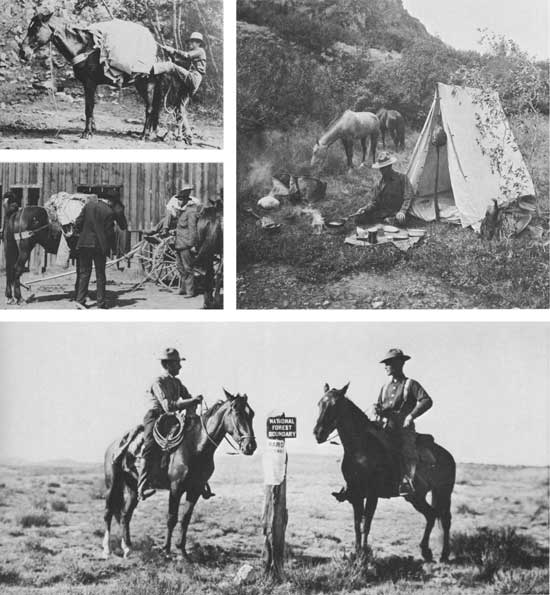
|
|
1 (top left) & 2 (middle left). Forest Ranger examinations
in the early years were practical and rigorous. Candidates had
to know how to throw a diamond hitch and pack a horse, show their
mounts, and ride. (Harold Greene, F—71225) 3 (top right). Long days and overnights were an
accepted part of the job, as this lone ranger attests. This was
in 1914 on the Wasatch National Forest, Utah. (F—21043A) 4 (bottom). Most jobs
in the field called for travel by horseback. This was the way the
original boundaries were marked on the San Isabel National Forest,
Colorado, in 1911. (F—00367A)
|
1905-1916

|
|
The first Forest Service homes and stations were rustic affairs:
cabins and houses adapted to the outdoor environment and rugged
way-of-life. 1 (top). Ranger Station on the Shoshone National
Forest, Wyoming, built about 1905. It may be the first one built
by the Forest Service. (Forest Service, Region 2, 7300) 2 (bottom left). This was an administrative
center within the Columbia (now Gifford Pinchot) National Forest,
Washington, in 1910. (F—514644) 3 (bottom right). Homegrown, whipsawn
lumber helped build Ranger Stations on the Flathead National
Forest, Montana, in 1908. (F—203047)
|

|
|
1 (top left). Meanwhile, back in Washington, D.C., Forest Service
headquarters occupied prominent downtown space for more than a
quarter of a century. (F—403371) 2 (top right). This was the first home of
the Forest Products Laboratory (Madison, Wisconsin), destined for
leadership in the field of research in wood utilization. (Forest Products
Laboratory, M 120 172) 3 (middle
right). The Forest Service Ranger's family was prepared in case of
fire at this Ranger Station on the Cibola National Forest, New
Mexico (July 1911). (F—02322A) 4 (bottom). The good life! This was the
Ranger Station in Aquachiquita Canyon, Lincoln National Forest,
New Mexico, in 1908. (F—53108)
|

|
|
1 (top). Oops! Traffic mishap on the Eldorado National Forest,
California, one summer day in 1914. (F—18462A) 2 (bottom). First load over
a new road carried office equipment for the Priest River Experiment
Station in the Kaniksu National Forest, Idaho (1911). White-shirted
Raphael Zon, on wagon seat, was a Forest Service Research pioneer and,
for many years, an Experiment Station Director. (The Priest River
Station was transferred to Missoula, Montana, in 1916 and Priest
River became an experimental forest.) (F—2265A)
|

|
|
1 (top left). Believe it or not, this creek bed was the easiest
route to travel into the back country of the Crook (now Tonto)
National Forest, Arizona, in 1910. (Harold Greene) 2 (top right). Dog sledding
was the best mode of winter travel on the Chugach National
Forest, Alaska, in 1914. (F—18653A) 3 (bottom). A popular travel vehicle
of the early 1900's, this old stage coach often carried 16 passengers
and baggage 54 miles over the Bitterroot Mountains from Red
Rock, Montana, to Salmon, Idaho. (F—84341)
|
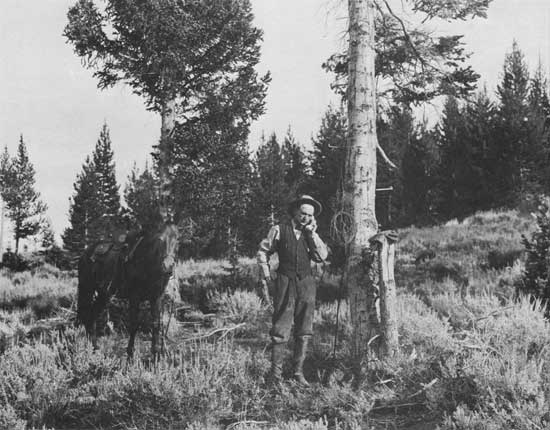
|
|
1. Forest officers on patrol used either a small portable telephone
that could be hooked into a temporary field line or permanent call
boxes to maintain contact with Ranger Station headquarters. (F—21039A)
|

|
|
1. Until portable radios were developed in the 1920's and 1930's, the
single wire telephone line (grounded) was the principal means of
communication with the men working in the National Forests. (F—18020A)
|

|
|
Through the years, Forest Service people have worked with and for all
kinds of people to so manage, protect, and develop the public forest
and range properly that all are properly served—people and natural
resources alike. The principle of "greatest good" has governed the
conservation movement in America. 1 (top). Local residents used timber
from the Black Hills National Forest, South Dakota, on a free-use basis
in 1913. Today free-use is largely limited to firewood from the National
Forests. (F—15626A) 2 (bottom). In 1913 a North Carolina mountain family depended
on the Pisgah National Forest to produce galax, useful in making wreaths
and other floral decorations. (F—15482A)
|

|
|
1 (top left). A daily chore at a homestead within the boundaries
of the Manti-LaSal National Forest, Utah, in 1912. (F—14762A) 2 (top right).
These were hardy homesteaders in the Ozark National Forest,
Arkansas, in 1914. (F—18090A) 3 (bottom). Shades of "Honest Abe" in a 1914
Ozark homesteader's cabin. (F—18929A)
|
"Without natural resources life itself is impossible. From birth to
death, natural resources, transformed for human use, feed, clothe,
shelter, and transport us. Upon them we depend for every material
necessity, comfort, convenience, and protection in our lives. Without
abundant natural resources prosperity is out of reach.
Gifford Pinchot (1898-1910)

|
|
1 (top left). Gifford Pinchot, Chief Forester, 1898-1910. (Drawing by
Rudolph Wendelin) 2 (top
right). Sheep grazing on the Kaibab National Forest, Arizona (1914). (F—19424A)
3 (bottom right). Cattle grazing on the Grand Mesa National Forest,
Colorado (1912). (F—54237)
|

|
|
1 (top). Montana lumberjacks in 1906. (F—523661) 2 (bottom). Summer home sites
were made available, under special use permit, in the Shasta National
Forest, California, in 1914. (F—19422A)
|

|
|
With the passing years, supervisory staffs and office work were
to expand as responsibilities were added. From the earliest days,
meetings were necessary to exchange views and experiences. 1 (top,
continued on next image). The District 3 (now Region 3) staff in
Albuquerque, New Mexico, in 1908. (F—242690) 2 (bottom). Forest Supervisor
Samuel J. Record (right) in his office in Mena, Arkansas, September
1908. He was Supervisor of the Arkansas National Forest, now the
Ouachita National Forest. (F—76568)
|

|
|
(top, continued from image above). 1 (middle left). Miss Finch, Clerk, Deputy
Supervisor L. E. Cooper, and Rangers Stell and Brown (sitting)
in the Supervisor's Office, Uncompahgre National Forest, Colorado,
in 1911. (Forest Service, Region 2) 2 (middle right). Ranger training meeting on the Coconino
National Forest, Arizona, at Fort Valley in October 1909. (F—90923) 3 (bottom
left). The first Ranger meeting on the Bighorn National Forest,
Wyoming, at Woodrock in November 1907. (Forest Service, Region 2) 4 (bottom right). Time out at a
Forest Service meeting on the Gila National Forest, New Mexico,
in October 1912. (F—14686A)
|

|
|
1 (top). A gathering of conservationists in the early 1900's included
President Theodore Roosevelt, Chief Forester Gifford Pinchot (back),
and Naturalist John Muir (fourth from right). The occasion was a field
trip in California. (F—517195) 2 (bottom left). President Theodore Roosevelt once
slept in this old cabin in Nail Canyon, Kaibab National Forest, Arizona. (F—444010)
3 (bottom right). Dr. Carl A. Schenck's Biltmore Forest School. Class
of 1905, in the Pink Beds section of what is now the Pisgah National
Forest, North Carolina. (F—238885)
|

|
|
1 (top). A 1912 field trip in the Harney (now part of the Black Hills
National Forest, South Dakota), included, from left to right, Capt. J.
A. Adams, Chief Forester Henry S. Graves, Secretary of Agriculture
James T. Wilson, Roy Smith, and an unidentified man. (F—18515A) 2 (bottom).
A research reconnaissance crew in camp at the Fort Valley Experiment
Station, Coconino National Forest, Arizona, in 1910. (F—93717)
|

|
|
1 (top). Loading a train with ponderosa pine logs at a railroad landing
near Belmont, Arizona, in 1911. (Harold Greene) 2 (bottom). "Big Wheel," 9 feet in diameter,
were used to bring the logs to be loaded. (Harold Greene)
|

|
|
1. En route to the mill. Such log rafts were not unusual in Washington
in 1910. (F—25756)
|

|
|
1 (top). Studies in methods of preserving wood occupied scientists at the
Forest Products Laboratory, which opened in 1910 in Madison, Wisconsin. (F—165834)
2 (bottom). Yellow poplar plywood sheet made in 1913. (F—17173A)
|
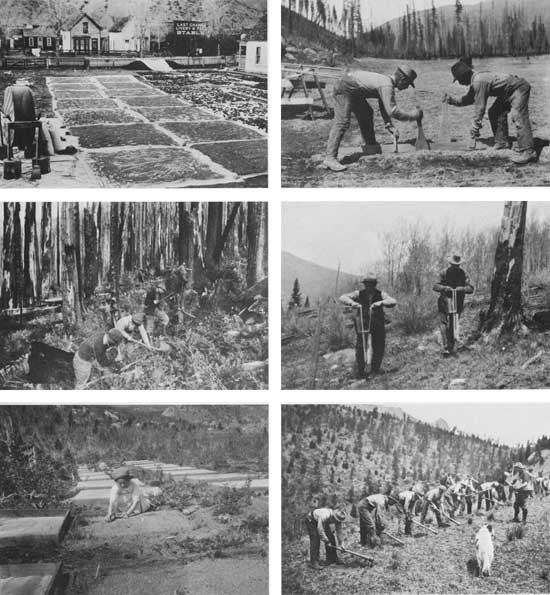
|
|
From its very beginning, the Forest Service has given consideration to replanting
cutover and burned-over areas. Much of the land within the newly proclaimed and
purchased National Forests were sorely in need of reforestation. 1 (top left).
Seed collected from ponderosa pine cones were thoroughly dried before planting in the
nursery or afield in the Uncompahgre National Forest, Colorado, in 1912. (Forest Service,
Region 2) 2 (middle
left). New trees were planted to replace the burned ones on the Mount Hood
National Forest, Oregon, in 1913. (F—17219A) 3 (bottom left). Research has long supported
Forest Service management. As early as 1912 studies in nursery practices were
conducted at the Manitou Peak Experimental Area, Pike National Forest, Colorado. (F—11923A)
4 (top right). Seedlings were transplanted in the Savenac Nursery, Lolo
National Forest, Montana, in 1912. (F—11148A) 5 (middle right). The cornplanting method of
putting Douglas-fir seed into the Colorado soil was used in 1911. (F—00860A) 6 (bottom
right). Crews worked to replenish the land on the Pike National Forest,
Colorado, in 1913. (F—17689A)
|
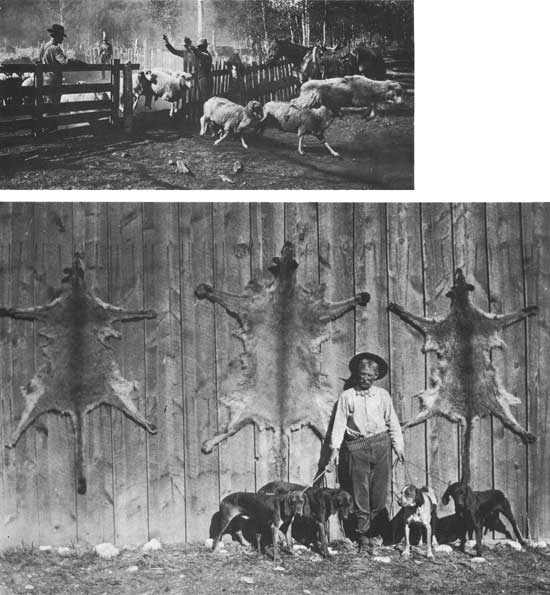
|
|
1 (top). On the Wasatch National Forest in Utah, in 1914, this was one way that
sheep heading into the open range were counted. (F—21582A) 2 (bottom). Trapper Jim Owens
was well known for his predator control activities on the Kaibab National Forest,
Arizona, in the early 1900's. This later led to severe overpopulation of deer
and to their widespread starvation. Increasing knowledge of natural processes
showed predator control to be misguided; the practice was halted except as a
solution to a specific problem in a specific area. (F—11168A)
|
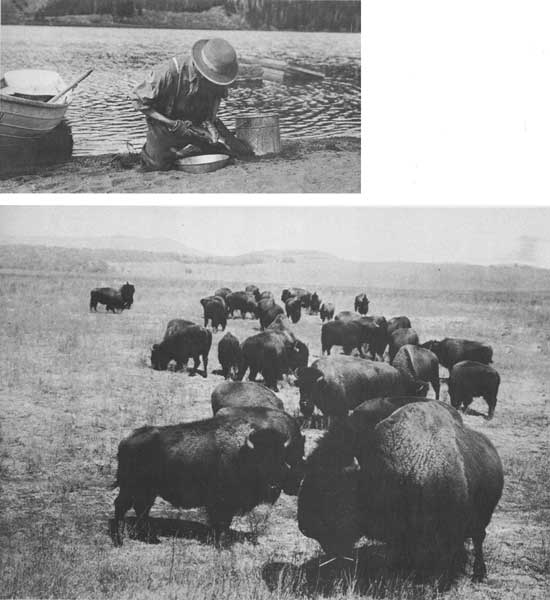
|
|
1 (top). On the Pike National Forest, Colorado, in 1911, a technician
fertilized trout eggs by "stripping" the male fish. (F—581A) 2 (bottom). In 1913,
the Forest Service was concerned with maintaining one of the last
then-remaining buffalo herds. This herd was established on the old
Wichita National Forest, Oklahoma, in 1907. This Forest became a
National Wildlife Refuge in 1936. By then Texas Longhorn cattle had
been added to the area. (F—17757A)
|

|
|
1. A Sunday drive among the giant Redwoods in the Six Rivers National
Forest, California, was a popular diversion in 1913. (F—18023A)
|
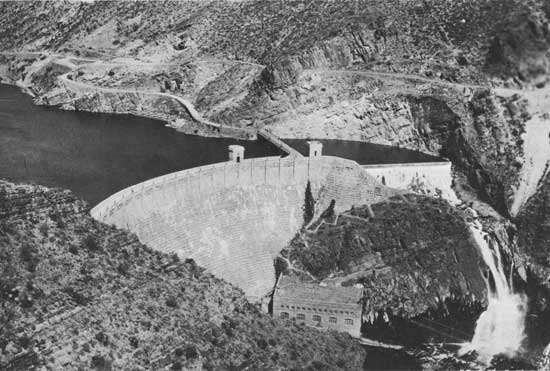
|
|
Water—one of the major natural resources—has always figured
heavily in Forest Service planning and administration. 1. This is a
1915 view of the Roosevelt Dam and Power Station (Bureau of Reclamation)
in the Tonto National Forest, Arizona. (F—29846A)
|

|
|
1. Forest fires resulting from lightning storms and from human carelessness
have hampered good forestry since the beginning of America's forestry effort.
In 1910, particularly, fires raged causing great damage and loss of life in
Idaho, Washington, and Montana. (F—479683)
|

|
|
1. Early morning view of an Idaho fire. (F—480830)
|
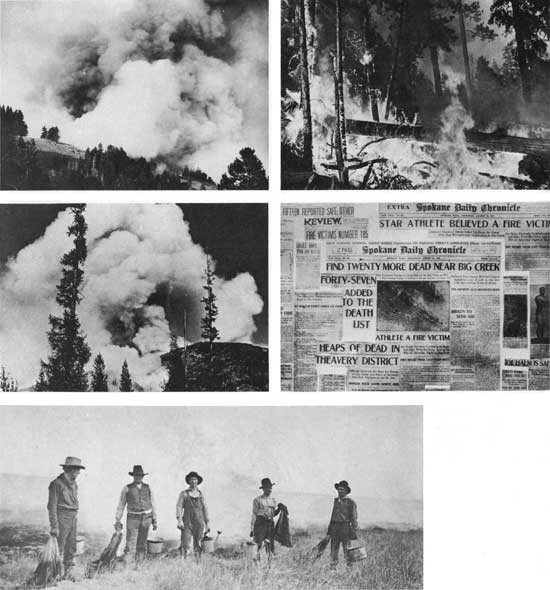
|
|
1 (top left). The Northwest had a rough time with fires in 1910. In the
Wallowa National Forest, Oregon, the Sleepy Ridge fire roared out of control
for a while and left in its wake destruction and ugliness. (F—185751) 2 (middle left).
Smoke column rises from a fire on Montana. (F—399997) 3 (top right). Forest fire in
Oregon. (F—468960) 4 (middle right). Copy of newspaper articles chronicling the 1910
fires in Montana. These fires claimed large numbers of victims and millions
of dollars in losses. (F—246027) 5 (bottom). The men were tough, their equipment crude,
as they fought fire in the old Wichita National Forest, Oklahoma, in 1912.
(The Forest is now a National Wildlife Refuge.) (F—12751A)
|

|
|
1. Surveying the damage caused by the 1910 Sleepy Ridge fire on the Wallowa
National Forest, Oregon. (F—185752)
|

|
|
1 (top left). Forest Ranger Griffin used map and compass, a natural overlook,
and a rock "desk" to figure the distance to a smoke just sighted in the Cabinet
National Forest, Montana, 1909. The Cabinet was divided among the Kaniksu,
Kootenai, and Lolo National Forests in 1954. (F—59299) 2 & 3 (top right). Harriet
Kelley was her name. In the summer of 1915 she could have been reached at a
lookout tower on the Tahoe National Forest, California, or on the trail
leading up to the tower, hauling water. (F—26755A, F—26756A) 4 (bottom). Ranger Jordan took his patrol
job sitting down with customary Forest Service ingenuity, Sierra National
Forest, California, March 1914. (F—18263A)
|

|
|
1. Lookouts were conscientious and devoted to duty and the lonely assignment.
Helen Dowe's station in 1919 was the Devil's Head Fire Lookout, Pike National
Forest, Colorado. (F—42829A)
|

|
|
"All work and no play . . ." Well, you know the rest. After all the hard
work, under difficult conditions, Forest Service people found ways to relax
and have fun. 1 (top left). Forest Ranger relaxing on the San Isabel National
Forest, Colorado, 1912. (F—12894A) 2 (middle left). Some say almost every Forest Officer
was born with a camera in his hand. There was much they could photograph in
1914 in New Mexico on the Santa Fe National Forest. (F—19440A) 3 (bottom left). This was
long before Smokey Bear. Supervisor's office, old Wichita National Forest
(now Wichita Mountains National Wildlife Refuge), Oklahoma, 1912. (F—12752A) 4 (top
right). Fourth of July celebration in Williams, Arizona, 1911. The winners:
foresters of the Tusayan (now Kaibab) National Forest. Their time was 3.2
seconds! (Harold Greene) 5 (bottom right). "Up, up, and away!" Planting camp, Nebraska National
Forest, 1914. This is the Nation's only totally planted National Forest,
occupying formerly unforested areas. (F—22227A)
|

|
|
1. Quiet moment at a fire overlook on the Shasta National Forest, California, 1914. (F—19473A)
|
aib-402/sec2.htm
Last Updated: 12-May-2008
|



































